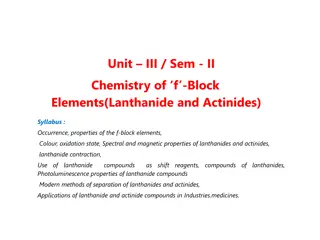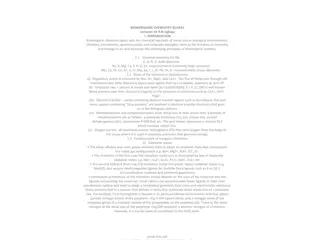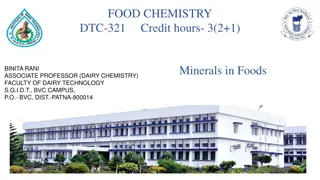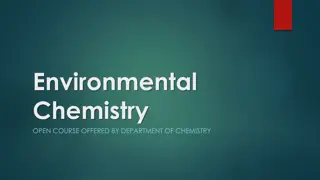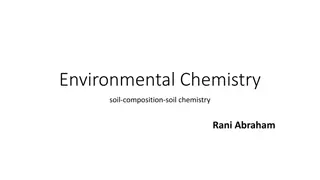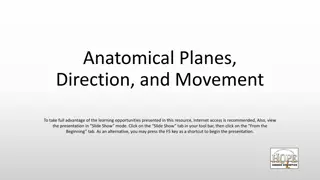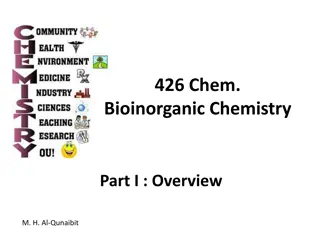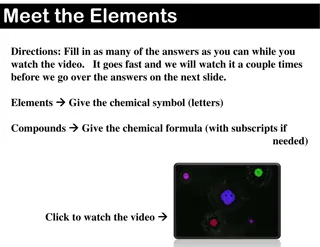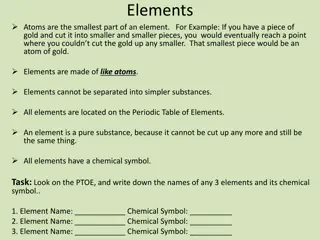Introduction to Bioinorganic Chemistry and Essential Elements in Human Body
Bioinorganic Chemistry explores the role of inorganic elements in living systems, emphasizing the essential elements present in the human body. Understanding the significance of metals, such as calcium, potassium, and iron, highlights their crucial functions and the impact of deficiency or excess on health.
Download Presentation

Please find below an Image/Link to download the presentation.
The content on the website is provided AS IS for your information and personal use only. It may not be sold, licensed, or shared on other websites without obtaining consent from the author.If you encounter any issues during the download, it is possible that the publisher has removed the file from their server.
You are allowed to download the files provided on this website for personal or commercial use, subject to the condition that they are used lawfully. All files are the property of their respective owners.
The content on the website is provided AS IS for your information and personal use only. It may not be sold, licensed, or shared on other websites without obtaining consent from the author.
E N D
Presentation Transcript
BioInorganic Chemistry Week 1 Dear students, Please go through these slides and solve the questionnaire in the last slide. Submit you answers through email on singhtaru.chem@gmail.com. No need to type the answers, just write the answers in your notebook and send me the scanned copy of notebook. In the coming week I will send questions which will be from the presentation and the topics that we have already covered in the class.
What is Bioinorganic Chemistry? Bioinorganic Chemistry is devoted to all aspects of inorganic elements (such as transition metals) as being vital for the growth and metabolism of living systems. Bioinorganic Chemistry is a multidisciplinary field which draws on expertise in biochemistry, chemistry, crystallography, genetics, medicine, microbiology together withthe effective application of advanced physical methods.
Elements in body Consider the content of the elements in the body of an average healthy person (weighing 70 kg). It has been established that out of 70 kg man s weight Oxygen accounts for 45.5 kg (more than half the total weight) Carbon accounts for 12.6 kg Hydrogen accounts for 7.0 kg Nitrogen accounts for 2.10 kg Phosphorus accounts for 700 g
Total weights of metals in gms Calcium 1050.0 Potassium 140.0 Sodium 105.0 Magnessium 35.0 Iron 4.2 Zinc 2.3 The content of rest of metals does not exceed one gram particularly Cu 0.11 g and Mn 0.02 g So in human body only 2% metals but life depends much more upon these elements far more than this figure suggests.
Classification of elements according to their action in the biological system
Essential elements are absolutely essential or necessary for life processes. Trace elements are also necessary for life processes. Non-essential elements are not essential. If they are absent other elements may serve the same function. Toxic elements disturb the natural functions of the biological system.
Metal ions their excess and deficiency Concentration of metal ions in human being s system is controlled within very fine limits. This control is generally exercised by certain biological complexing agents. The deficiency or excess of metal ions causes disorder, which leads to various diseases.
Magnesium Magnesium, an abundant element in the earth s crust, is vital to both plant and animal life. Chlorophyll pigment in plants is a Mg-porphyrin complex. All enzymatic reaction in animals and men that are catalyzed by ATP require Mg as a cofactor. Oxidative phosphorylation, DNA transcription, RNA function, protein synthesis and critical cell membrane functions are all dependent upon optimal Mg concentrations. An average man has about 35g Mg, out of this 99% is either intracellular or in bone, of the 60% in bone, two-third is tightly incorporated into the mineral lattice, but one-third is in an apparently exchangeable bone surface pool. Dietary sources high in Mg include nuts, sea foods, legumes and vegetables, meat is intermediate in Mg content. Potassium An adult human has approximately 140 g K of which >90% is both intracellular and exchangeable (K is the predominant cation in intracellular water) since muscle contains most of the body s intracellular water, it also contains most of the K. Since K is found in most animal and vegetable foods, dietary deficiency is exceedingly rare except under unusual conditions (such as diets very high in refined sugars, alcoholic individuals deriving most of their calories from low-K alcoholic beverages in the states of starvation etc.).
Sodium Sodium is the predominant extracellular cation in animals and man. An adult human has about 105 g Na, about 24% is located in bone and about 65% in extracellular water. Sodium ion equilibrium is maintained primarily by the kidney, the key organ in water and electrolyte balance. Sodium chloride (salt) is the predominant dietary source. Although excessive dietary Cl appear to have no significant ill effect on health, there is much evidence that excessive Na intake results in elevated blood pressure (hypertension) and that reduces Na intake or increased K intake helps to reduce high blood pressure.
Movement across membranes There are two ways in which substances can enter or leave a cell: 1) Passive a) Simple Diffusion b) Facilitated Diffusion c) Osmosis (water only) 2) Active a) Molecules b) Particles
Diffusion Diffusion is the net passive movement of particles (atoms, ions or molecules) from a region in which they are in higher concentration to regions of lower concentration. It continues until the concentration of substances is uniform throughout. Some major examples of diffusion in biology: Gas exchange at the alveoli oxygen from air to blood, carbon dioxide from blood to air. Gas exchange for photosynthesis carbon dioxide from air to leaf, oxygen from leaf to air. Gas exchange for respiration oxygen from blood to tissue cells, carbon dioxide in opposite direction. Transfer of transmitter substance acetylcholine from presynaptic to postsynaptic membrane at a synapse. Osmosis diffusion of water through a semipermeable membrane.
Facilitated Diffusion This is the movement of specific molecules down a concentration gradient, passing through the membrane via a specific carrier protein. Thus, rather like enzymes, each carrier has its own shape and only allows one molecule (or one group of closely related molecules) to pass through. Selection is by size; shape; charge. Common molecules entering/leaving cells this way include glucose and amino-acids. It is passive and requires no energy from the cell. If the molecule is changed on entering the cell (glucose + ATP glucose phosphate + ADP), then the concentration gradient of glucose will be kept high, and there will a steady one-way traffic.
Osmosis Osmosis is a special example of diffusion. It is the diffusion of water through a partially permeable membrane from a more dilute solution to a more concentrated solution down the water potential gradient) Note: diffusion and osmosis are both passive, i.e. energy from ATP is not used. A partially permeable membrane is a barrier that permits the passage of some substances but not others; it allows the passage of the solvent molecules but not some of the larger solute molecules. Cell membranes are described as selectively permeable because not only do they allow the passage of water but also allow the passage of certain solutes. The presence of particular solutes stimulates the membrane to open specific channels or trigger active transport mechanisms to allow the passage of those chemicals across the membrane.
Osmosis Some major examples of osmosis Absorption of water by plant roots. Re-absorption of water by the proximal and distal convoluted tubules of the nephron. Re-absorption of tissue fluid into the venule ends of the blood capillaries. Absorption of water by the alimentary canal stomach, small intestine and the colon.
Water Potential This is the tendency of water to move from one place to another. Values are always negative! Water always flows downhill i.e. towards the more negative number. Units are pressure (kPa) Calculations are not set, but this formula may be: Water Potential ( ) = Pressure Potential ( p) + Solute Potential ( s) Pressure Potential = the force of the cell wall on the contents, so for animal cells, this is zero, thus, in animals: Water Potential ( ) = Solute Potential ( s)
Active Transport Active transport is the energy-demanding transfer of a substance across a cell membrane against its concentration gradient, i.e., from lower concentration to higher concentration. Special proteins within the cell membrane act as specific protein carriers . The energy for active transport comes from ATP generated by respiration (in mitochondria). Major examples of Active Transport Re-absorption of glucose, amino acids and salts by the proximal convoluted tubule of the nephron in the kidney. Sodium/potassium pump in cell membranes (especially nerve cells)
Questions: 1. What do you understand by essential and non-essential metal ions in the biosystem? 2. Differentiate between active and passive transport? 3. What do you mean by essential, non-essential, trace and toxic elements in biological system? Give suitable examples. 4. Define Osmosis and Diffusion.




